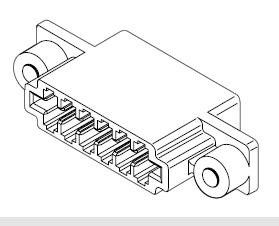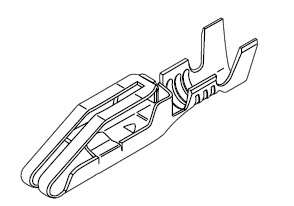nuckolls.bob(at)aeroelect
Guest
|
 Posted: Sat Aug 21, 2010 12:59 pm Post subject: Tray Connectors...OOPS. Posted: Sat Aug 21, 2010 12:59 pm Post subject: Tray Connectors...OOPS. |
 |
|
Somehow the image for the card-edge-finger pin
got replace by a second housing image. Here's
the corrected piece.
B . . .
| Quote: | | I am sure the notion of sliding a piece of electronics into a tray with the connector on the back has some informative design history, but it is a horrible idea for aircraft (and even cars). In general you should avoid it and replace the connector with a hanging one where the connections aren't attached to two separately moving bodies. |
It's true that connectors at the rear of
slide-in accessories mating with connectors
on captive trays have extra-ordinary design
requirements. And there were a few radios
wherein the designers had to learn the
weaknesses in the worst way - field experience.
Many of the first radios for GA aircraft didn't
even mount on the panel. Take this cute little
feller . . .
http://tinyurl.com/29sfmdd
This radio was battery powered and not intended
to be mounted solidly to the airplane. See the
leather carrying handle? One sat it in the seat,
plugged in an antenna, headphones and mic and voila!
You had an airborne radio communications system.
The antenna was in fact, a device adapted from a
car radio installation. You talked on a VHF frequency
determined by which crystal you plugged into the
panel (see slots for two other frequencies)
and listened for the ground facility to
reply over the local radio range, LF beacon
or marker transmitter.
Not too many years after, folks began to find
ways to mount these new fangled devices to the
panel and it didn't take long to realize that
it was MUCH easier to do installation and maintenance
if the mounting tray and harness was captive
to the airplane and the radio simply slides into
the tray. Exemplar radios included this device.
http://tinyurl.com/29hm578
You can see the head of the radio-to-tray
jackscrew at the upper edge of the LF receiver
bezel.
http://tinyurl.com/2c5hu4w
The other end of the jackscrew can be seen
here along with the Cinch-Jones connectors
that mated with connectors captive to the
tray. These connectors are still in production.
http://tinyurl.com/yhm37ow
At the same time, other manufacturers elected
not to participate in that adventure. As I
recall, this radio's installation tray
http://tinyurl.com/3xklhct
did not capture the mating connectors. The
maintenance person had to crawl under the
panel to mate/de-mate harnesses with the
radio.
Even today, the installed size and wire-count
of some radios . . .
http://tinyurl.com/2u58jrb
doesn't offer practical tray designs and
their mating harness connectors are captive
directly to the radio chassis.
Aircraft radios did suffer a sort of "dark
ages" when connectors intended to engage card-
edge fingers were pressed into service on
new designs. King radio (and others) built a
LOT of devices that used this genre' of wire
to board connector:
[img]cid:.0[/img]
That accepted pins looking like this:
[img]cid:.1[/img]
At Cessna in 1963 or so, we did an audio distribution
board that mounted some relays and provided a sort
of junction box for integrating a stack of radios
into the single-engine product line.
The card-edge connector was imply not designed to
perform well in the aircraft environment. The
in-house experiment only lasted a few years. Recall
that good connection science calls for low surface
area, high-pressure contact between pin and socket.
The thin, gold-plated fingers of soft copper and the
wide, low pressure springs in the pins simply did
not rise to the task. Further, these connectors are
probably the most fragile interconnect devices
ever. They are entirely suited for SOME limited
applications and are still made . . . but you won't
(or at least shouldn't) find them in a product
destined for use in an airplane.
These connectors are not well contained. Dust
laden with moisture, oils, and grit can accumulate
over time. There's no wire support to keep harness
wiggles from "working" the pins in their housings.
I'd venture a guess that 90+ percent of my
observations of "connector grief" with panel mounted
radios in light aircraft have involved a variant
of a card-edge-to-wire product.
Having said that, I'm not sure I'd recommend a
great migration to modifying any radio that's still
in service utilizing this connector style. It
would probably be useful to install new pins in
all the holes. Clean the card edge fingers
with a solvent wetted swab (resist any
temptation to buff with ANY form of abrasive),
that gold plating is VERY thin! Then provide
bundle support for the wires close to where
they exit the connector housing.
Beyond this example of mis-applied technologies,
I think the researcher will find that tray
mounted harness connectors have enjoyed secure,
happy and long lived associations with their
radio mounted mates. The design has been widely
practiced over the full range of avionics from
the present day descendant of the Mitchell Airboy up
to and including electro-whizzies in military
and spacecraft.
The magic happens when the connector pin-socket
combinations are truly crafted to the task,
harnesses don't hang from the pin's insulation
grip, housings do a good job of shielding pins
from the environmental crud, and finally, the
radio is properly captive in the tray by proper
tightening of the retaining hardware.
By the way, if any of you are interested in a
little museum trip down Avionics Lane, I'll invite
you to look over the collection of pictures here:
http://aeroelectric.com/Pictures/Radios/
Some of us grey beards have had the pleasure
of cranking on a few of these very same knobs.
My first flying lesson in a rudder-pedal fitted
included a how-to session on one of these:
http://tinyurl.com/3xklhct
Bob . . .
| | - The Matronics AeroElectric-List Email Forum - | | | Use the List Feature Navigator to browse the many List utilities available such as the Email Subscriptions page, Archive Search & Download, 7-Day Browse, Chat, FAQ, Photoshare, and much more:
http://www.matronics.com/Navigator?AeroElectric-List |
|
| Description: |
|
| Filesize: |
28.86 KB |
| Viewed: |
1293 Time(s) |

|
| Description: |
|
| Filesize: |
23.52 KB |
| Viewed: |
1293 Time(s) |

|
|
|




